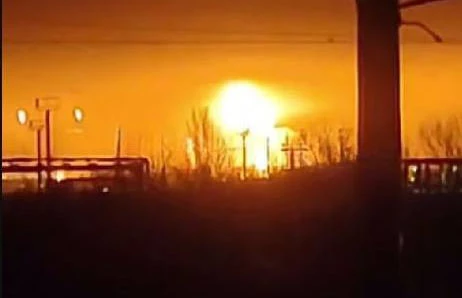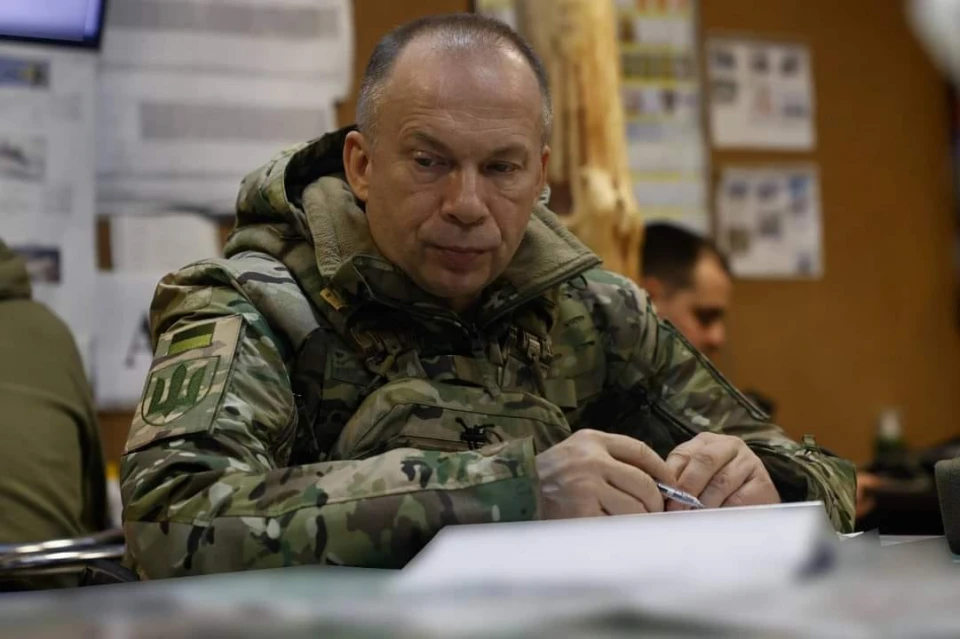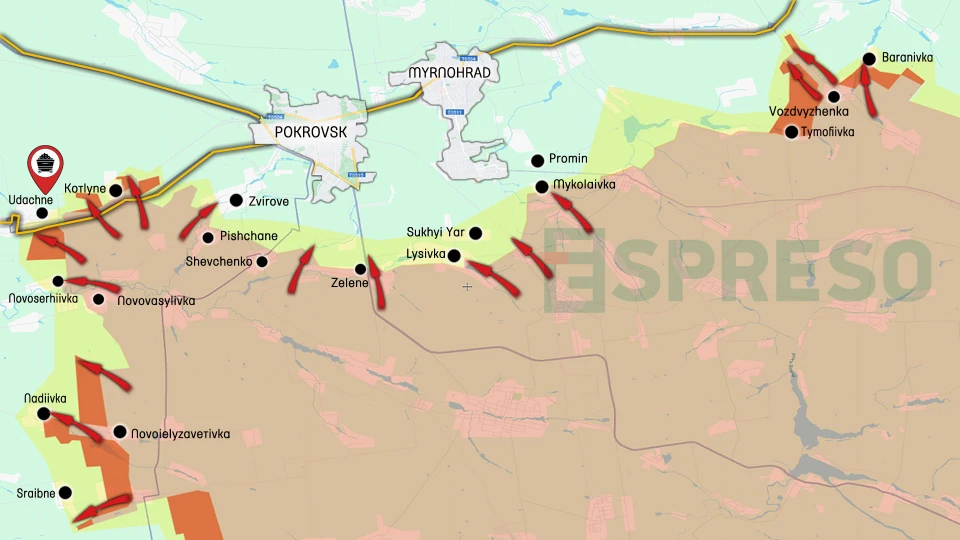
Russian advance slows down, how Ukrainian Armed Forces approaches change. Serhiy Zgurets' column
Russian forces captured 300 km² in January, 452 km² in December, and 700 km² in November, indicating a decrease in the intensity of Russian advances
Attack on Russian fuel and energy facilities
On the night of February 3, Ukrainian drones attacked Russian fuel and energy facilities. The Ukrainian General Staff reported that the strikes took place at the Volgograd Oil Refinery and Astrakhan Gas Processing Plant in Russia, which produce a large amount of fuel for Russia. The operation was carried out by the Special Operations Forces and the Security Service of Ukraine in cooperation with other units of Ukrainian Defense Forces. Fires are still burning at both plants.

This is the fifth strike by Ukrainian drones on the Volgograd refinery, which is one of the largest refineries in Russia that produces gasoline, fuel oil, aviation and diesel fuel. This means that this refinery produces about 7% of diesel fuel for the Russian Federation.
Strikes on oil refineries are intended to significantly complicate the logistics of the Russian army. It is important to take into account the statistics, in particular, compared to 2023, Russian oil supplies in 2024 fell by 10%.
Last year, there were over 80 strikes on Russian oil refineries — specifically, 84 strikes reaching depths of up to 1,500 kilometers. In January alone, more than 20 such strikes were carried out. That is, the system is aimed at inflicting maximum damage to Russia with Ukrainian long-range strike systems.
January's results — Commander-in-Chief Syrskyi's assessment
Let's now talk about how January went. Commander-in-Chief Oleksandr Syrskyi yesterday summarized certain results on Facebook. He also highlighted the destruction of Russian targets deep inside Russian territory and the operation in the Kursk region as priorities for the Ukrainian Armed Forces. He also spoke about holding defensive lines, preventing enemy advances, strengthening military training, and expanding the UAV component. Regarding drones, the emphasis is on the fact that Ukrainian Ground Forces, Air Assault Forces, Marine Corps, and Unmanned Systems Forces are currently being reinforced by expanding units and increasing the number of unmanned system units.

When we talk about January, Russian forces made the least progress since August 2024. They managed to capture over 300 km² of Ukrainian territory in January, compared to 452 km² in December and 700 km² in November. This indicates a decrease in the intensity of Russian advancement.
There could be several reasons, starting with the depletion of the Russian army's potential, although I wouldn't draw such a conclusion just yet. On one hand, weather plays a role, and on the other hand, Russia's losses in manpower and equipment, due to the actions of Ukraine's Defense Forces, are making it impossible for them to advance effectively according to the goals they have set.
Oleksandr Syrskyi also said that reforms would be carried out in the Ukrainian Armed Forces. In the context of the reforms, he mentioned the beginning of the transition to a corps structure of the army. Actually, we have heard about the transition to a corps structure before, it was first mentioned in November last year.
A couple of weeks ago, there was a meeting of the Supreme Commander-in-Chief, where Volodymyr Zelenskyy also said that the issue of forming corps in the Ukrainian Armed Forces was among the most pressing issues.
There is some specificity regarding this, although we do not know all the details at the moment. However, we understand that this is a step in the right direction, as currently, the largest tactical military unit used by the Ukrainian Armed Forces in combat is the brigade.
The grouping of brigades is subordinated to the Operational and Tactical Group. The management system has certain flaws because a large number of brigades subordinated to the operational group creates some problems in terms of effective management. Not all commanders know the status of the brigades, the complexity of interaction, etc. And now it is believed that it is probably necessary to switch to corps structures.
A corps can consist of divisions and brigades, with a total personnel of up to 50,000. It is believed that the approach now will involve newly formed corps, which, by the way, already exist in the Ukrainian Armed Forces, having one zone of responsibility. The corps commander will be responsible for the entire range of tasks, from taking control of a specific area to defense and preparing personnel. All of this will fall under the corps commander's responsibility, who will integrate all these capabilities. It is through such a new combat unit that the current issues with attached units and management complexity can be mitigated.
Currently, the Ukrainian Armed Forces have several corps: the 9th, 10th, and 11th Army Corps, the Marine Corps created in 2023, the Air Assault Corps, and the Rangers Corps in the Special Operations Forces. However, the key issue is not the name itself, but rather the application of the structure as a unified military entity within a specific zone of responsibility, with all the advantages of this organizational structure.
It is difficult to say when this will be implemented, but it is extremely important that such changes are already being announced by both the president and the Commander-in-Chief. Of course, this should have been done earlier, but better late than never. It is crucial that this reform leads to a result aimed at improving effectiveness. This is the component we desperately need to truly gain an advantage over the Russians on the battlefield.
Situation on frontline — Pokrovsk direction
Currently, 60% of combat clashes are concentrated in the Pokrovsk direction. Russia is trying to press on the western and eastern flanks from Pokrovsk, but their advancement has recently stalled as their progress across all areas has been significantly hindered. This is likely due to changes in the approaches of the Ukrainian Armed Forces or the addition of forces to deter the invader.

Ukraine Russia war live map, January 22-29, Photo: Espreso
Call sign "Goose", commander of the aerial reconnaissance unit of the 2nd battalion of the 68th separate Ranger Brigade from the Pokrovsk direction, said that the intensity of Russian attacks in the brigade's area of responsibility has not decreased. The weather only affects the work of drones, and Russian infantry assaults continue. Russian forces use the vehicles to transport their personnel. After the Russian capture of Novohrodivka and Selydove, Russian soldiers began to travel in Zhiguli and Nyva, which they took from the local population, so they began to use armored vehicles less. They mostly travel in pickup trucks, buggies, and sometimes motorcycles.
The serviceman said that in Russian infantry assaults, several fighters initially go to gain a foothold. Usually, most of such a group is destroyed by Ukrainian soldiers, but 1-2 soldiers try to hold on if they find a dugout somewhere nearby. Then other groups continue to join them. And when they accumulate up to 10-15 people, they then attempt an active assault. In this way, the Russians accumulated on the front line in dugouts, huts, basements, that is, closer to Ukrainian positions. In most cases, Ukrainian defenders very quickly identify such places of Russian concentration and target them with all means: FPV drones, artillery, mortars, heavy bombers, etc. If any of them remain and try to attack, as soon as they leave their hiding place and come out into the open, they are immediately destroyed.
The unit commander noted that a Russian special unit called “Judgment Day” occasionally operates in the Pokrovsk direction; these are FPV drone pilots who are quite skilled and therefore annoy Ukrainian units. Ukrainian guys are making efforts to identify the Russian pilots' points of interest in order to work on them immediately. It should be noted that the Russian army neglects not only the safety of its infantry, but also of UAV pilots. That's why it's easier for Ukrainian defenders to get them, because Russian pilots come close to the front line to fly from there.
"Goose" added that today's weather conditions are unfavorable for both Ukrainian and Russian "birds". The Russians are trying to use this weather to move as unnoticed as possible, to get closer to the positions. But they are still detected, so their attacks do not go unanswered.
- News











































